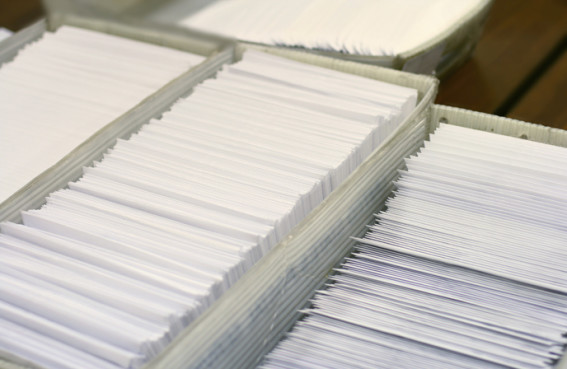If you want to substantially reduce your postage costs on a large mailing, you should consider sending it standard mail, which is the Post Office’s term for “bulk mail”. Using standard mail will save a for-profit business at least 38% off of first-class postage rates, and savings of up to 55% are possible if you use commingling or drop shipping to get the mail to mail entry units close to the mail’s ultimate destination. Nonprofits will save even more by using standard mail – nonprofit standard rates are between 55% and 80% less than first-class postage rates. Learn more about how to maximize your bulk mail savings.
How to do a bulk mailing: The following is an overview of what you must do to qualify for standard mail pricing for a typical enveloped or postcard mailing:
- Quantities: In order to be eligible for standard rates, your mailing must consist of at least 200 identical pieces of mail.
- Standard Mail Permit: You must have a standard mail permit to ship standard mail, which you can apply for using USPS Form 3615. In order to keep your permit imprint account active, you must pay an annual permit fee of $225 and do a bulk mailing at least every two years. Nonprofits need to separately apply for nonprofit status using USPS Form 3624. You must apply separately to each post office entry unit at which you plan to drop off mail.
- CASS Certification: CASS stands for “Coding Accuracy Support System”. CASS certification standardizes address data by fixing street and city misspellings, confirming the carrier route, checking five- and nine-digit zip codes, and creating an accurate delivery point barcode. You or your postal logistics company must run your data file through CASS certification software within 180 days of the date of your mailing for non-carrier route mailings (90 days for carrier route). You must confirm which software you used and the date on which the data file was processed on USPS Form 3553 for each mailing.
- Check against the National Change of Address (NCOA) database: With one in every six American families moving each year, making sure the addresses in your mailing list are correct is an ongoing challenge. The USPS requires that your mailing list be compared with the Postal Service’s database of known address changes within 95 days of the date of the mailing. The USPS may perform a Performance-Based Verification on a sample from your mailing, and if it finds that more than 30% of the addresses for which a change of address has been submitted are not updated, you will be charged extra for the mailing. Learn more here.
- Be Automation Compatible: In order to qualify for the lowest rates, letters and cards must meet certain physical standards. Letter-size mail should be rectangular with dimensions of at least 5 inches long, 3.5 inches high and 0.007 inches thick. It must weigh no more than 3.3 ounces and not have dimensions larger than any of the following – 11.5 inches long, 6.125 inches high and 0.25 inches thick. Letters must either be in a sealed envelope or, if not in an envelope, all four sides of the mailing need to be completely sealed. Learn more here.
- Addressing: Envelopes need to contain a complete address within the defined Optical Character Reader area and, in most cases, a complete return address. In order to be automation compatible, the envelope must include an Intelligent Mail Barcode that incorporates a tracking code and a delivery point routing code in a series of 65 vertical bars. Learn more here.
- Postage: Postage must be paid with permit imprint, meter indicia, precanceled stamps, or other accepted methods that do not require cancellation. The class of mailing (such as “Presorted Standard” or “Nonprofit”) must be printed directly below or to the left of the imprint or stamp, and other price-specific markings may also be required. More specifics here.
- Sorting and Bundling: You must have at least 150 pieces going to a 5-digit or 3-digit zip code area in order to qualify for lower rates. If you have at least 150 pieces which are sorted together for a specific 5-digit zip code (such as 21401), the current rate you’ll be charged is $0.266 per piece if you drop the mailing off at the nearest bulk mail entry unit. If you don’t have at least 150 pieces going to 21401 but you do have 150 pieces with zip codes starting with “214”, you qualify for the 3-digit rate of $0.283. And if you are able to deliver the trays of mail to the Sectional Center Facility (SCF) serving the 21401 area, you’ll only have to pay a postage rate of $0.221 and $0.238 for 5-digit and 3-digit bundles, respectively. Be sure to follow the USPS’s detailed requirements for bundling and traying presorted mail to avoid problems at the entry unit.
- Sleeving, Strapping and Tagging: Each tray of mail needs to be inserted into a sleeve that wraps around the tray, strapped once lengthwise around the tray, and tagged according to the USPS requirements. Learn more here.
- Documentation: Each mailing delivered to a USPS entry unit must be accompanied by paperwork produced by Presort Accuracy Validation and Evaluation (PAVE)-certified or Manifest Analysis and Certification (MAC)-certified software that outlines the name of the mailer and the mailing, a mailing identification code, the date, the class of mail, and the DMM standard (such as 245.10.0 for standard mail automation letters) being claimed. The paperwork needs to contain separate columns with the number of pieces for each price broken out by 5-digit and 3-digit zip codes, grouped by sortation level (e.g., 5-digit, 3-digit, carrier route, Mixed ADC, SCF, NDC, etc.) and pallet for larger mailings. At the end of the documentation, a summary of the number of pieces mailed at each price by postage payment method and by entry point, as well as the number of pieces in each mailing, must be included. More specifics here. Presort and price documentation are not required for mailings of fewer than 10,000 pieces if the correct amount of postage is affixed to each piece or if pieces are separated by price when submitted to the postal unit.
- Deliver to bulk mail entry point: The final step in sending your standard mail is to deliver it to the appropriate bulk mail entry unit with its documentation. If you have enough pieces going to a particular Network Distribution Center (NDC) or Sectional Center Facility (SCF) that the savings more than offset the freight costs of getting it there, you can hire a freight company to drop ship the mail. Alternatively, you can hire a commingling company like MailSmart Logistics that will maximize your savings by picking up your entire unsorted mailing, combining it with other mail, and delivering it as close as possible to its ultimate destination. MailSmart Logistic’s clients typically commingle at least 2 million pieces of mail a year and save an average of 12% off of standard mail rates.
Feeling a Little Overwhelmed?
We understand. The world of postal logistics is surprisingly complicated. If you’re small and just starting out, you may want to hire a mail house or presort bureau to help you comply with USPS regulations. If you’re doing enough mailing to use commingling, your MailSmart Logistics account manager will happily work hand-in-hand with you to maximize your savings on all your direct mail while minimizing the work you need to do yourself.
MailSmart Logistics provides worry-free shipping at remarkably-low postal rates –
You’re going to love working with MailSmart Logistics!






